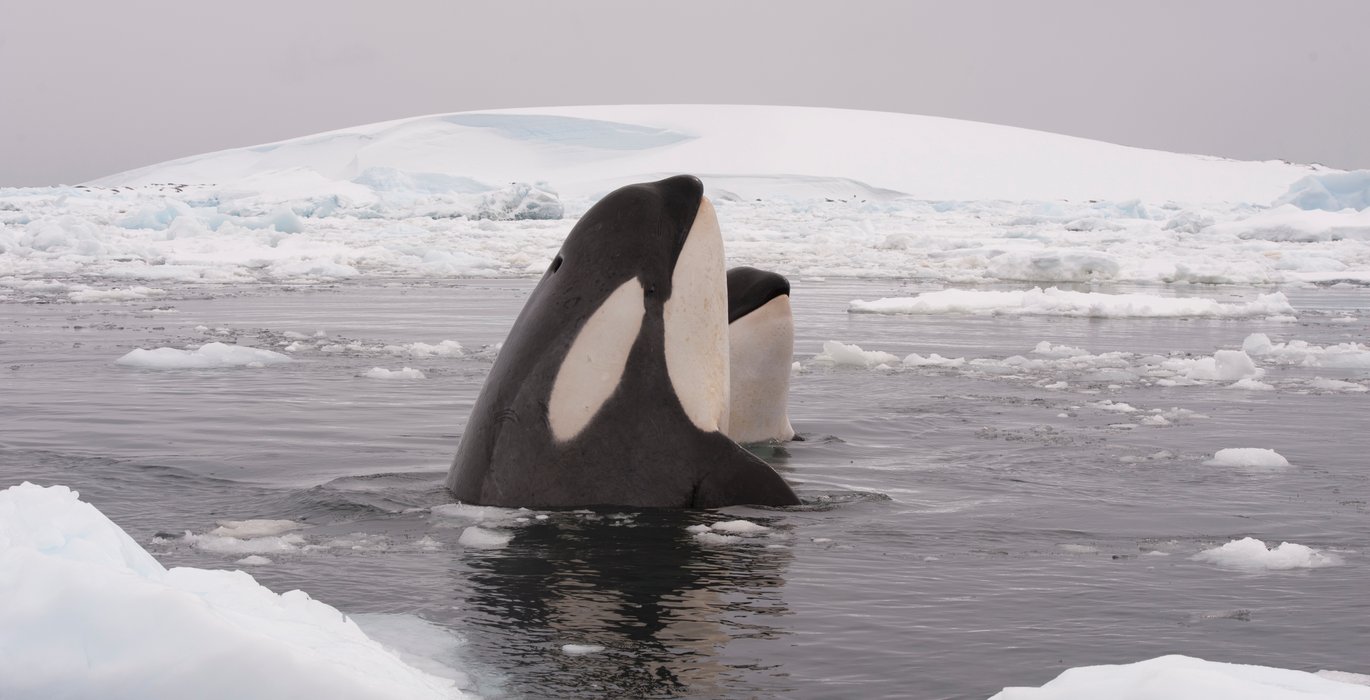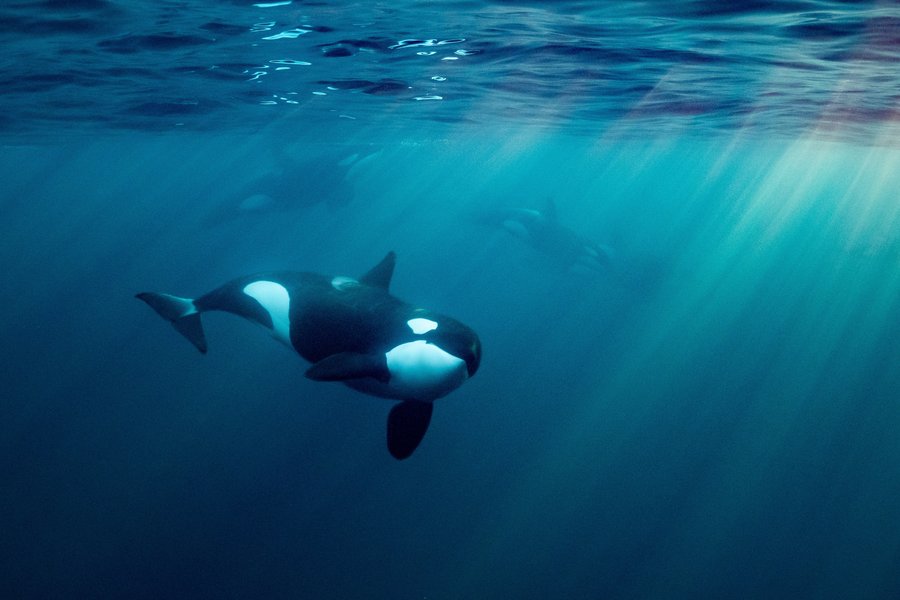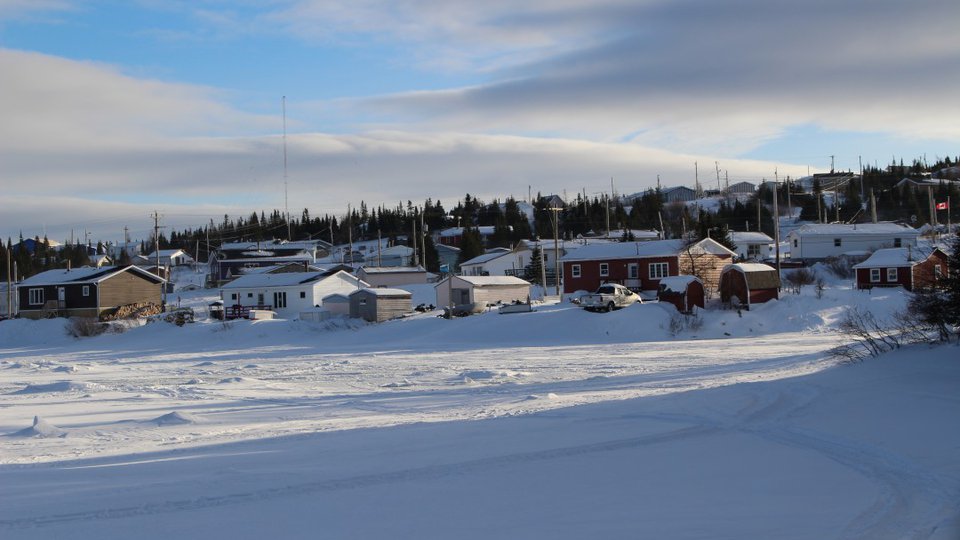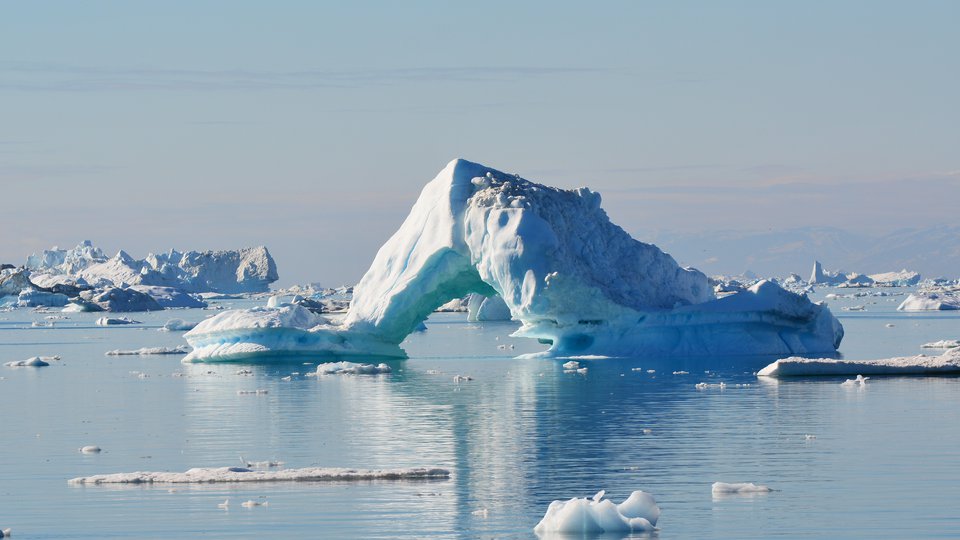
Life’s a buffet, and not everyone wants the same thing on their plate–even, it seems, among orcas (Orcinus orca). A recent study from McGill University of Northern Atlantic orca populations showed substantial differences in diet and feeding behaviours not only based on region but between individuals, which could hold important clues about how climate change and pollution impact Arctic food webs.
The largest member of the dolphin family, male orcas can grow up to 9 meters (30 feet) in length and weigh up to 7,300 kilograms (16,000 pounds), with dorsal fins as tall as a full-grown man. Living up to 70 years in the wild, killer whales are both highly intelligent and highly social animals; cohabitating in matrilineally-dominated groups, called pods, individuals not only form complex relationships with each other, but learn and pass on information between each other–what might be thought of as having “culture.” As such, different pods from different regions may have different vocalizations, interpersonal behaviours or other “customs,” including diet, even when they live in close proximity to each other in similar habitats.
“We all love killer whales, because they’re so amazing–they’re the kings of the ocean...Sadly for us, we don’t know much about what (Atlantic) killer whales eat, and that’s really important for the ocean, because killer whales are super important to the ocean’s food chain.”
While variations in food preferences have been well documented in Pacific Northwest orca populations–resident Pacific populations, for example, may remain year round and feed primarily on a smorgasbord of local fish, such as salmon, while transient populations are migratory and prefer the grab-and-go convenience of marine mammals, such as seals–much less is known about the dinner habits of Northern Atlantic killer whales.
Understanding what these animals eat, however, and where, is vital information, says Anaïs Remili, lead authour of the study and a PhD candidate in the department of natural resources, because we need baseline data in order to recognize dietary changes and their potential impacts on Arctic food webs as a whole. As apex predators, what orcas eat (or do not eat) affects not only their own health and survival, but can have a cascading impact on other species, and on the ecosystem as a whole.
To see how this works, imagine, as an example, that about half the orca pods in a region primarily eat ring seals–also the favourite food of polar bears– while the other half mainly eat other whales, such as narwhals, which, as the study found, is the case for about half orcas sampled in Canada’s Eastern Arctic.
Arctic narwhals themselves primarily eat fish, such as cod and halibut, along with squid and shrimp. Cold-water-loving species like these are highly susceptible to rising ocean temperatures, as increased temperatures can create an imbalance in their metabolic needs and the amount of dissolved oxygen available to them in their environment, which can impact their distribution, range, and overall survival.

Photo: Adobe Stock
A recent 2023 study, for example, predicts that the increasing climate change-related water temperatures in the Arctic ocean could have “potential severe effects” on fish like halibut. If, as the climate changes there are fewer fish–or the fish are in places they haven’t traditionally lived–there’s less food for narwhals.
As the population of narwhals declines, whale-eating orcas either starve or change their hunting strategies; some of those whales now turn to eating ring seals. Seals primarily eat fish, which, in this imagined scenario, would likely also be impacted by the same changes as the cod and halibut the narwhals were eating; now the seals have more trouble getting their own dinner even as they become dinner more often. Declining seal populations mean less to eat not only for polar bears, which further impacts and weakens their population, but also for humans, such as the Inuit of Nunavut, for whom seals are a vital cultural and subsistence staple.
“We all love killer whales, because they’re so amazing–they’re the kings of the ocean,” says Remili. “Sadly for us, we don’t know much about what (Atlantic) killer whales eat, and that’s really important for the ocean, because killer whales are super important to the ocean’s food chain.”
It’s notoriously difficult to study the diet of northern Atlantic killer whales; you have a lot of ocean and relatively few whales, so even just finding them can be a challenge. In order to gather this hitherto missing data about Atlantic orca diets, Remili and her team developed a new way of determining what the whales were eating–analyzing the pattern of fatty acids in their blubber. To get the blubber, the team employed a technique called remote darting, says Remili, which is exactly what it sounds like: using a small projectile, researchers collect a tiny piece of skin and the blubber beneath it, which can be used to analyze their diet.
Although being darted is an uncomfortable thought for a person, Remili says the technique is minimally invasive for something as large as a killer whale, and that remote darting is a normal and well-accepted part of global whale monitoring programs.

Photo: Adobe Stock
To collect the sample, Remili says a team of researchers approach the whale on a small boat, moving as slowly as possible to avoid scaring it. When they’re within about 15 meters of the whale–approximately three car lengths–they shoot the dart using an air gun or crossbow; the dart has a hollow tube on the end that collects the sample, which is taken from the layer of fat just below the skin. When the dart is retrieved, it contains a tiny sample, which is only about as large as “the first knuckle of (her) pinky” finger, Remili says.
“It's a very small piece of tissue, but from this one piece we can conduct many different analyses that will tell us about the genetics of this individual or what it eats or how contaminated it is,” says Remili. “So it's a very precious little piece of a sample.”
While the remote darting method is common, Remili’s team came up with the technique of using these lipid samples to determine diet using a technique called Qualitative Fatty Acid Signature Analysis (QFASA). QFASA, which the team validated by comparing the stomach contents of harvested or beached killer whales with the fatty acid signatures identified in their blubber, allowed them to not only determine what the whales were eating, but what specific foods made up specific percentages of their diet. This allowed the team to determine what orca groups were eating what, where, and when, and compare those groups to each other.
In addition to diet, Remili used the samples to look at contaminants–basically, what bad stuff the whale had picked up and was carrying around in its blubber, and where it might have acquired its toxic load.
“Contaminants like to bind to lipids, and so you can look at the lipids and the blubber…and look (for) another type of chemical tracer that's called stable isotopes. They also inform us on the feeding habits of these individuals,” says Remili, adding that because contaminants tend to accumulate as they move up the food chain, an orca with a lot of contamination could be expected to be feeding more on marine mammals, like whales or seals, as opposed to fish, a logical assumption her team confirmed using the new QFASA technique.
Looking at samples from around 200 killer whales and 900 possible prey species taken from across more than 5,000 KM of Atlantic Ocean, Remili and her fellows found that different killer whale pods eat different things in different regions; orcas in the Eastern Atlantic ate mostly baleen whales, like minke and humpbacks, along with harbour porpoises, while Arctic orcas ate predominantly belugas and narwhals.
While geographical differences in diet, however, were to be expected–different locations would naturally be expected to have different prey species and distributions–what the team didn’t expect was how much diet differed between pods in the same region, and even between individuals within pods.
“I never knew before the study that we were going to find such a large difference between individuals,” she says. “That’s really what surprised us.”
Essentially, some orcas even within their own pods, have different prey preferences, even when the same food sources were present for all orcas within the pods; in human terms, this is like how you might prefer toast for breakfast but your partner would rather have eggs, even if you have both options in the kitchen–or that perhaps you can’t make eggs as well as your partner, so you settle for making toast instead.
Remili and her team referred to these differences as Individual Specializations (IS), and created an index within groups to compare each sampled whale to the others in its region; the closer the individual’s score was to 1, the closer its diet was to the mean diet of its home population. Killer whales samples in Norway and Iceland, for example, had an overall IS rating of 0.8, which indicates that individuals within that population all tend to eat alike, where as whales, while whales sampled from Greenland had an IS score of 0.58, which indicates a much higher degree of individual dietary variation; some orcas in this region primarily ate seals, while others are far fewer seals, adding varying levels of fish and whales into the mix.
“What this means in terms of ecology is that, (because) killer whales are the top predators in the (Atlantic) ocean, they have a cascading effect…depending on what they decide they’re going to eat, and considering that they’re going to eat a lot of it, they affect the entire food chain,” says Remili.
For example, one well-documented study of Pacific orcas, the whales were found to be eating so many sea otters that sea urchin populations, on which sea otters feed, exploded. Sea urchins eat kelp, which forms underwater forests; because the killer whales were eating too many sea otters, there were too many sea urchins, which began to overfeed on the sea kelp forests, damaging them and impacting other forms of marine life. Without similar baseline data on what killer whales typically eat and how much, there’s no way to study or predict similar events in Atlantic populations, which is part of the reason for the study, says Remili.
“This paper was just looking and comparing those diets across the North Atlantic, but in future studies we can look at the effects of this predation on the different food webs,” she says.





